Lantau has been described as, “Hong Kong’s biggest and most beautiful island.”
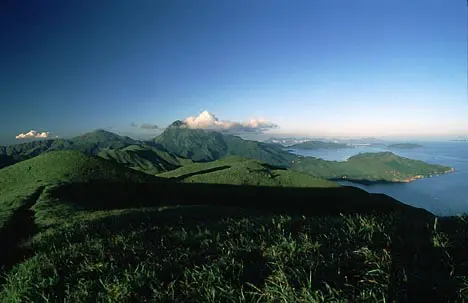
I’d love to magically transport someone to Ling Wui Shan, southwest Lantau Island, and ask, “Where in the world are you?”
“A wild, remote place,” might be the first impression, for Ling Wui Shan is the highest point on a stout peninsula of rippling hills, clothed in hardy grass and scrub. It caps the southernmost crest of hills, above slopes plunging to the sea. Just offshore is a cluster of islets, likewise green and with no buildings in view. Inland is a tight group of mountains, their summits often swathed in low cloud.
Only ferries passing in front of the islets, and two or three fragments of urban areas just visible near the horizon, suggest Ling Wui Shan is not really remote. It’s in a region renowned worldwide as a densely packed city – Hong Kong, above the southwest tip of its largest island, which exhibits similar contrasts between urban and rural landscapes to Hong Kong overall.
This island, Lantau, is at the mouth of the Pearl River, a location reflected in the identities of those just visible urban areas: Hong Kong Island to the east, Macau across the Pearl River to the west, and Shenzhen in mainland China to the north. Viewed from Ling Wui Shan, Lantau appears completely free from urbanisation, without even towns or villages. Nearby are waterfalls in steep ravines, a temple tucked into a wooded hillside, and even a Chinese style landscaped garden that’s reached only by hiking. Walking here when the sky is intense blue, it’s easy to agree with former Financial Secretary (and former Chief Executive wannabe) Henry Tang’s description of Lantau as, “Hong Kong’s biggest and most beautiful island.”
A Brief History of Lantau Island
Lantau’s beauty is less obvious along the north coast. Here, Hong Kong International Airport occupies a platform built in the 1990s by levelling two small inshore islands and reclaiming the sea around them – resulting in a far less nerve wracking approach to Hong Kong than the previous descent skimming the roofs of Kowloon apartments – and there are a nearby new town, Tung Chung, plus a highway and railway that lead east, and cross a suspension bridge built to link the airport with the city. The railway also includes a station where passengers can change to the short line to the world’s smallest Disneyland, which occupies reclaimed land in a bay in southeast Lantau, and opened in September 2005.
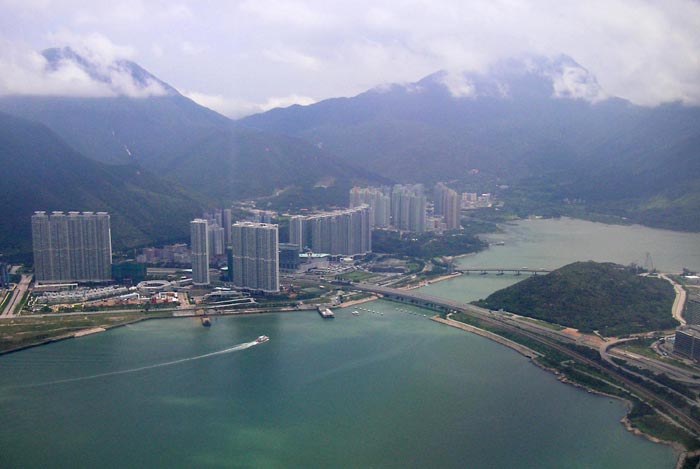
Tung Chung is little but a cluster of characterless high rises, with some malls, outlet stores. But it has an old temple and two forts that reflect ways Lantau featured in the early history of southern China. Built in 1777, the temple is dedicated to Hau Wong, uncle and bodyguard of the last two boy emperors of the Song dynasty (960-1279), who fled to Lantau and other places in south China when Mongols invaded during the late 13th century. Two Qing Dynasty forts were built here in the early 19th century, to help guard the approaches to Guangzhou (Canton), which lies to the north along the Pearl River.
Since at least the Song Dynasty, pirates menaced shipping plying the river. The most infamous was Cheung Po-tsai, who commanded a fleet of over 270 ships and 30,000 men, and even aimed to overthrow the Qing Dynasty. He was eventually defeated in 1810, in a battle off Chek Lap Kok – the present day airport – with Chinese, British and Macanese ships. Today, the sea here is best known as the haunt of Chinese white dolphins, which are grey when young but lose their pigmentation to appear bubble-gum pink as adults: an ecotour company bills them as “the world’s pinkest dolphins”. They are locally endangered, chiefly because of pollution.
Though coastal waters witnessed skirmishes and skulduggery, the island’s hills became a haven for Buddhists. By the 1970s there were reportedly 135 Buddhist monasteries with around 500 monks, and Lantau was sometimes called the Island of Prayer.
Po Lin Monastery, Ngong Ping – no longer a Buddhist experience
The best known of the monasteries is Po Lin – Precious Lotus – at Ngong Ping, an upland basin flanked by Lantau’s highest mountain, 934-metre Lantau Peak. It originated as stone huts built by three reclusive monks in 1905, and was then accessible only on foot.
Even by the 1960s, Po Lin was a small temple, but grand new monastery buildings opened in 1970. They are colourful, with red outer walls and yellow roof tiles. In the main hall, the floor is adorned with Lotus flower patterns, and three Buddhas sit on three Lotus flowers. By the courtyard is a small pond, with Lotus plants: growing in stagnant, muddy water, yet producing beautiful flowers, they reveal the potential for anyone to attain enlightenment and purity.
The 34-metre high Big Buddha – the world’s largest, seated, outdoor Bronze Buddha – was since built on a hilltop in front of the monastery. Completed in 1993, it helped make Ngong Ping a major draw for visitors, who began pouring in by the busload, especially during weekends and holidays. This year, Ngong Ping became one of Hong Kong’s prime tourist attractions, with the opening of Ngong Ping 360 Skyrail – a cable car from near the airport. As well as the monastery and Big Buddha, tourists can walk around an artificial “village”, and visit an array of wooden logs with a classic Buddhist text, the Heart Sutra, carved into them to entertain visitors.
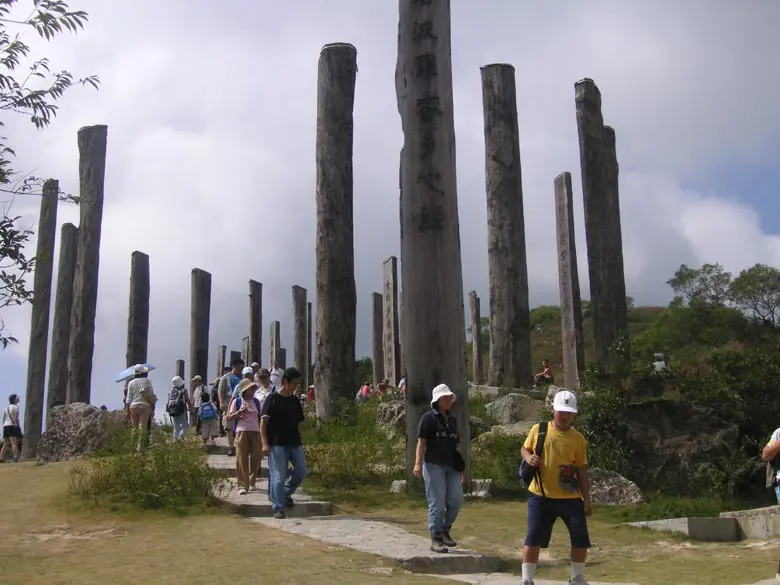
With taped, traditional Chinese music playing from loudspeakers, and tour groups led by guides with megaphones, Ngong Ping today would astonish but probably not delight those original, reclusive monks. Certainly the members of local conservation group the Green Lantau Association aren’t impressed. “It’s not a Buddhist experience,” says Clive Noffke, excecutive committee member of the association. “The GLA no longer visits Ngong Ping on our hikes.”
Noffke is a New Zealander who has lived in Hong Kong for 31 years, staying on Lantau in the early 1980s, and since visiting often before taking up residence on the south coast four years ago. “It reminds me of New Zealand,” he says. “There are mountains, beaches, a low density population, and greenery. It’s wonderfully quiet, with old villages I find culturally interesting. I can’t imagine anywhere I’d rather be.”
Tai O: the people and environment are so close
One of Lantau’s largest old villages is Tai O, on the west coast. It hugs the shores of two creeks that form as a stream meets a hilly island, and forks north and south before entering the sea. Schoolteacher Ho Pui-han began working and living here in 1992, and soon came to love her adopted village. “The scenery is very beautiful. I found it a comfortable, relaxing place,” she says. “You get to know each other; people and the environment are so close.” Unlike typical Hong Kong residential areas, Ho found she could readily call on friends for tea or coffee, or when she wanted a walk. When her daughter was born in 2002, Ho moved to a high-rise housing estate north of Kowloon, finding doors are closed and she says little but “Hello” to neighbours. But she still often visits Tai O, keeping close contact with friends there.
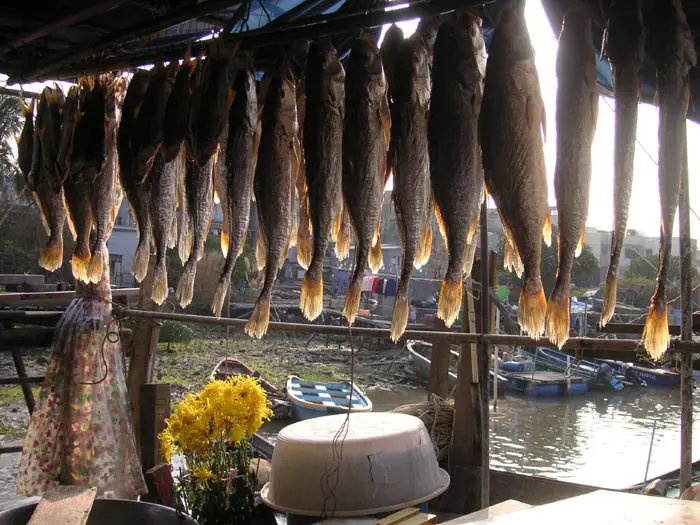
Tai O’s main local residents, the Tanka, are South China fisherfolk who evidently took to building houses from boats that were no longer seaworthy, and which they placed on stilts by the water. The designs evolved to purpose-built stilt houses, which line the creeks, and make Tai O picturesque. Narrow paths link the houses, turning and twisting through narrow alleys and along verandas above the water. Some houses are decorated outside with flowers, perhaps near rows of fish hanging on lines, or trays of tiny shrimps, placed in the sun to dry.
Dried, salted seafood is a hallmark of Tai O, which was formerly the centre of a salt industry. At high tide, the salt workers filled saltpans, where the water was allowed to evaporate, and the salt was gathered for collection and sale. The saltpans were perhaps first built during the Sung and Tang dynasties (7th – 13th centuries). The last of them were used until the early 1960s, after which they were abandoned; one area of old saltpans has recently been planted with mangroves.
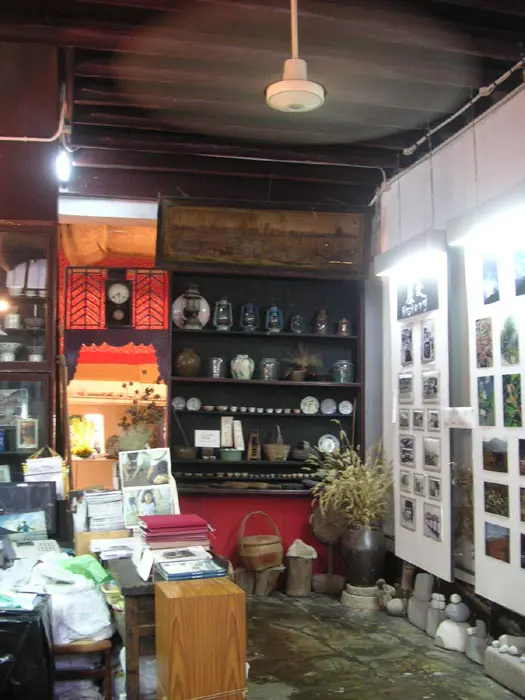
In 2001, Ho’s friend Wong Wai-king opened a small museum, with exhibits including traditional clothing, furniture, and fishing gear, in turn inspiring the rural committee to open a similar museum close by. Outside these museums, along a main street, Tai O itself is like a living museum. The street is a pedestrian thoroughfare, running parallel to the southern creek, past stalls with locally made dried seafood and shrimp paste, dried fruit and tourist souvenirs, as well as small restaurants and shops. Stallholders include elderly women in pyjama-like clothing and bamboo hats to guard against the sun.
Buffalo on the south coast; lots of natural surprises
More villages dot Lantau’s southern coast, lying at the base of hills by flat or gently rolling parcels of land that were used for growing fruits, vegetables, and rice. Built by farmers, not fishermen, none have stilt houses, and today the predominant buildings are modern, three-storey “Spanish villas”. Farming across Hong Kong steeply declined in the 1970s, partly as cheap imports made growing crops such as rice uneconomic, and though there is some market gardening, Lantau’s paddyfields have been abandoned.
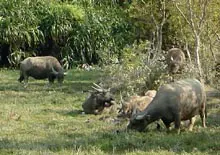
Water buffalo roam the former paddyfields. They are descendants of a few animals that were left to fend for themselves, as they were no longer needed for pulling ploughshares, and now over a hundred live wild on Lantau. Though they’re huge, heavy beasts, they pay little attention as people pass by, too intent on munching grass and wallowing in the mud.
Most of the buffalo are at Pui O, where in the late afternoon, they are fond of heading down to the sea to bathe. Pui O resident Loy Ho, the founder of community newspaper Lantau Post, enjoys having the buffalo in the area. She has lived on Lantau for over 16 years, after scouring Hong Kong to find a place where human beings can live without artificial constraints. “Lantau has the closest to the original natural beauty you can find in Hong Kong,” she says. “It’s still undeveloped – you can have your own space, with a green environment, as well as fresher air and cleaner water. There’s no need to take an elevator to go into your home. There are lots of natural surprises, whether you walk up hills or along streams – like a natural butterfly garden where I’ve seen thousands of butterflies.”

To anyone unfamiliar with Lantau, another natural surprise might be an almost two-kilometre long beach, close by the main road along the south coast, yet shielded by shrubs and trees. As you stroll eastwards, the road swings away, so the views are dominated by beach, sea, and hills. Especially on weekdays, this can seem a secret place, somehow hidden even though buses pass right by, their passengers perhaps intent on joining the throngs at Ngong Pingand the Big Buddha.
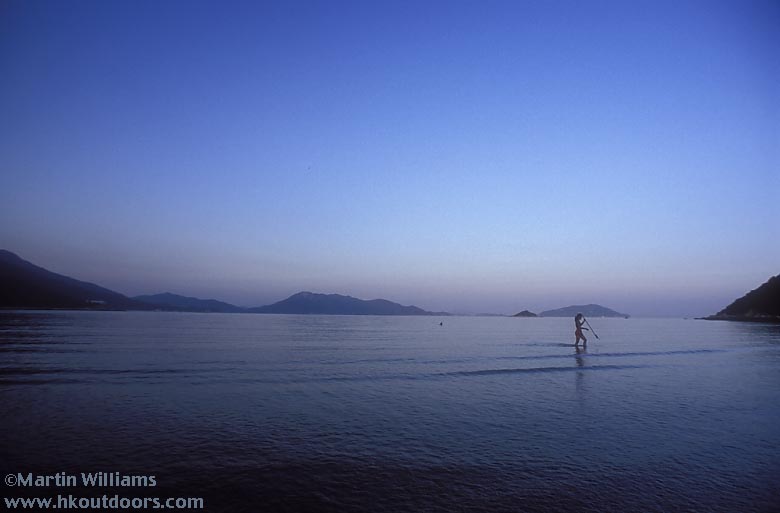
Just west of the beach is Shui Hau, with small mudflats that teem with shellfish,including cockles harvested by elderly residents. At dusk on a clear summer day, shallow pools mirror Lantau Peak and neighbouring hills, and the flat calm sea melts into the deepening blue sky. Night falls, leaving more secrets and surprises to discover another day.
This article first appeared in the October 2006 issue of Skyward, the inflight magazine of Japan Airlines.















photos
great photos and videos you give great examples
Epic! I must visit these places
Epic! I must visit these places, especially since I go back to college in the states in about a month